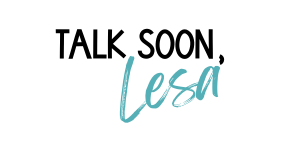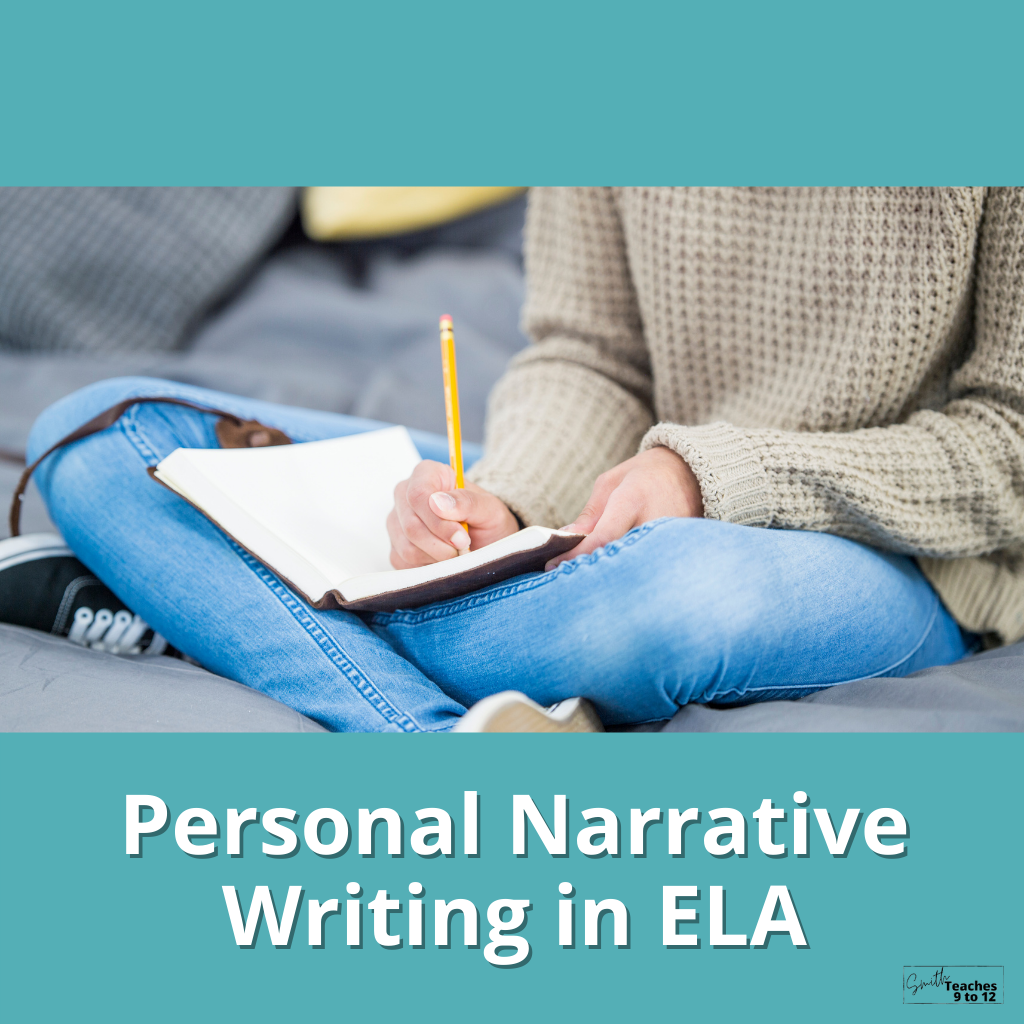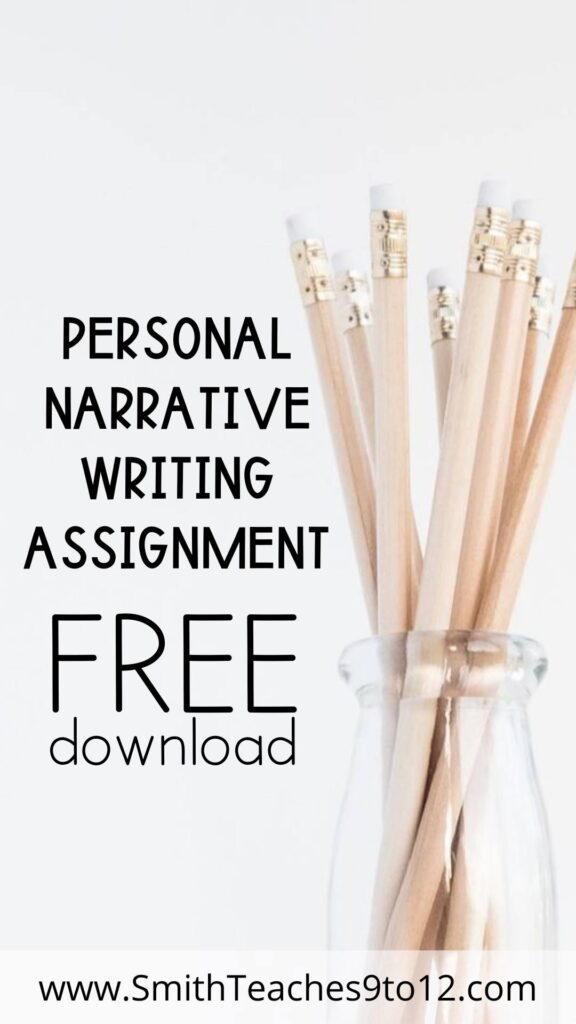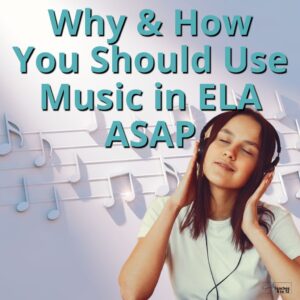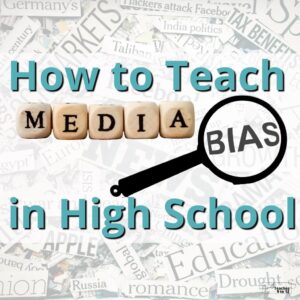Sharing is caring!
Personal narrative writing has been a success for me and my senior students in English. It works because students gain comfort with “I” as a starting voice, sharing an experience on their terms, and going through an editing process. I like to do this early in a course so it works for a change in semester or at the start of a new school year/course.
Keep reading for a bit more detail about the rationale for timing, an overview of the process including personal narrative topics, teacher participation… AND a freebie personal essay assignment with a writing rubric to get you started in your classroom!
Why Personal Narrative Writing?
First, the use of “I” in writing is often overlooked; teachers, myself included, often push students to a more neutral voice. But we’re hearing more from university instructors that using “I” is not the negative that it might have once been. This post from A Better Way to Teach and this essay from The Atlantic share more on this topic.
There are times when students have to seriously contort a sentence, when using “I” could make it straightforward!
Second, students are able to share a personal experience on their terms. Since it’s the start of a course, it’s imperative to provide students choice and space to share how much/little they want. The goal here is not to bare one’s soul on the first day! Instead, such writing can provide a starting point for building relationships in class.
Providing personal narrative prompts with flexibility is key. You can encourage students to be as personal as they like with such narrative prompts. Some students go right into things whereas others are more reluctant, the writing topics should provide that degree of flexibility.
Finally, as part of the exploration of boundaries and comfort with sharing personal experiences students also work through the academic aspect of editing.
To start, students read a lot of personal essays – some old, some new. Through this process, they create a list to fit the genre – what are the “must haves” for a personal narrative essay. Co-create an anchor chart with these elements and then use the criteria as self or peer assessment (if students are comfortable sharing their work). And then this criteria can be part of the writing assignment rubric for a personal narrative essay assignment – students are co-creating the criteria, which often adds to the chances of success with an assignment.
How Does It Work?
Start with a free write as a diagnostic in the first few days of class in order to get a baseline for students’ writing style, structure, skills, as well as their habits before, during, and after writing a piece. This data is invaluable in meeting students where they are and to scaffold learning with this assignment and the course too.
It begins as a 20-minute free write with some prompts displayed for students. I do not share with them that this will turn into an assignment; I just indicate it’s a first writing sample for the class. And I indicate that this writing will only be shared with me, though if there are concerns about their well-being I will need to share with others such as guidance or administration; but I make clear that if this is not a writing assignment they want to share with their classmates that will not be required (this is why I include options for self or peer assessment).
Here are the narrative writing prompts I use:
- Write about a personal experience/event that has shaped you and your view of the world.
- Write about a person who has had a great influence on you and your view of the world. This may be someone you know in real life or a ‘celebrity’.
- Write about a text (book, movie, song) that has shaped you and your life.
Students submit their drafts for review – not to be marked, just for recording initial observations and providing descriptive feedback. The data might include reluctance, thinking time, sustained writing time, whether they rush or are methodical and so on. These observations can create a baseline and are only one instance of data at the start of the course. More free writes will be done as the course continues and so data can be expanded or updated.
After the Free Write
Once returned, this free write turns into their first assignment. I like to give students the chance to develop what they have or to start fresh with a different topic/subject.
From there review figurative language devices, examine mentor pieces (see options listed below), and then students begin the work of revising their own personal narrative essays.
- How can they paint the picture of the moment in their essay?
- What sensory details will they include?
- What stylistic elements will they want to include?
- What should stay and what needs to go from that initial draft?
- How might they include dialogue in their narrative?
Many newspapers and magazines continue to have a first-person or personal narrative section. Finding essays that are timely and relevant to the students in your class will make this even more meaningful.
Here are four such links:
- Personal Essay from Teen Vogue
- First Person from The Globe and Mail
- First Person from NY Magazine
- Memoir from Toronto Life Magazine
These essays can be mentor texts and the publications can provide options to submit finished work to too! These sources provide a variety of topics and most have free access to their archives too.
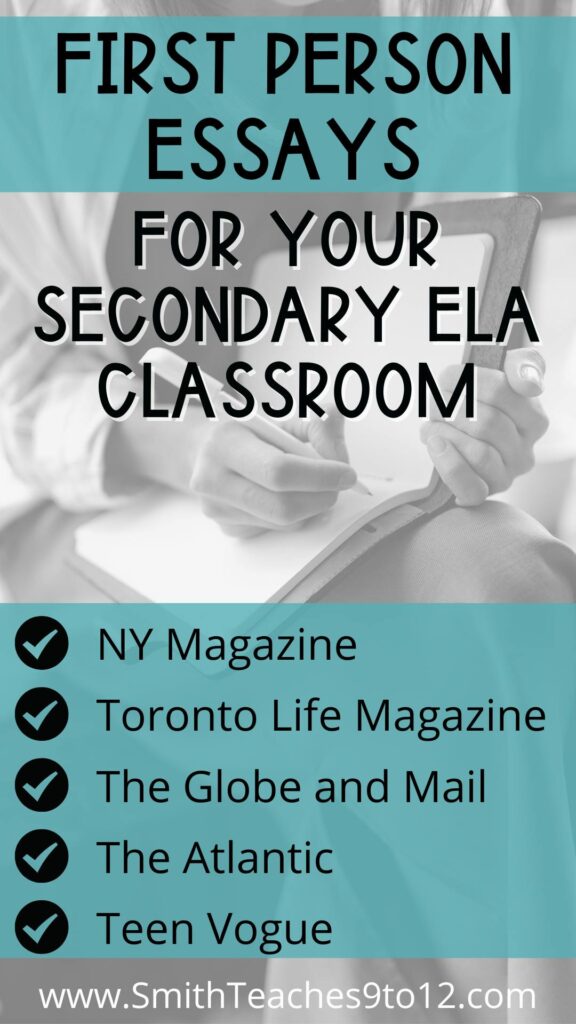
Reviewing the Work
Another part of the review process can be a self or peer edit using co-created criteria for first-person essays; this is where the mentor texts add purpose.
To add a bit of fun to this review process, have students play the board game Taboo. The goal of the game is to get someone to guess a word or phrase without saying specific related words. This exercise gets students thinking outside the box and expanding their skills with description – both helpful for reviewing their drafts.
A purchase through this link means I earn a small commission that helps to keep this website up and running to provide more content for high school ELA teachers!
As a final option, I encourage students to submit their work for potential publication. This is entirely optional! Provide students with the guidelines and submission process, particularly if the publications are where you’ve sourced mentor texts. This adds an authenticity to the assignment as well.
Teacher Participation in Personal Narrative Writing
While students write, I urge you to write too. I try so I can remember the feelings that go with the process and to model that it isn’t always easy! Writing is work… even for English teachers!
Every year I switch up the prompt I respond to or search for a new way to answer. Every year my draft comes in handy to model editing – better to mark up a ‘neutral’ version than a student version. Plus, sometimes it’s used as an essay for peer editing if someone doesn’t want to share or isn’t at the point of sharing.
And in the end, it’s a nice bonus to end up with an essay focused on a moment in time in your own life!
